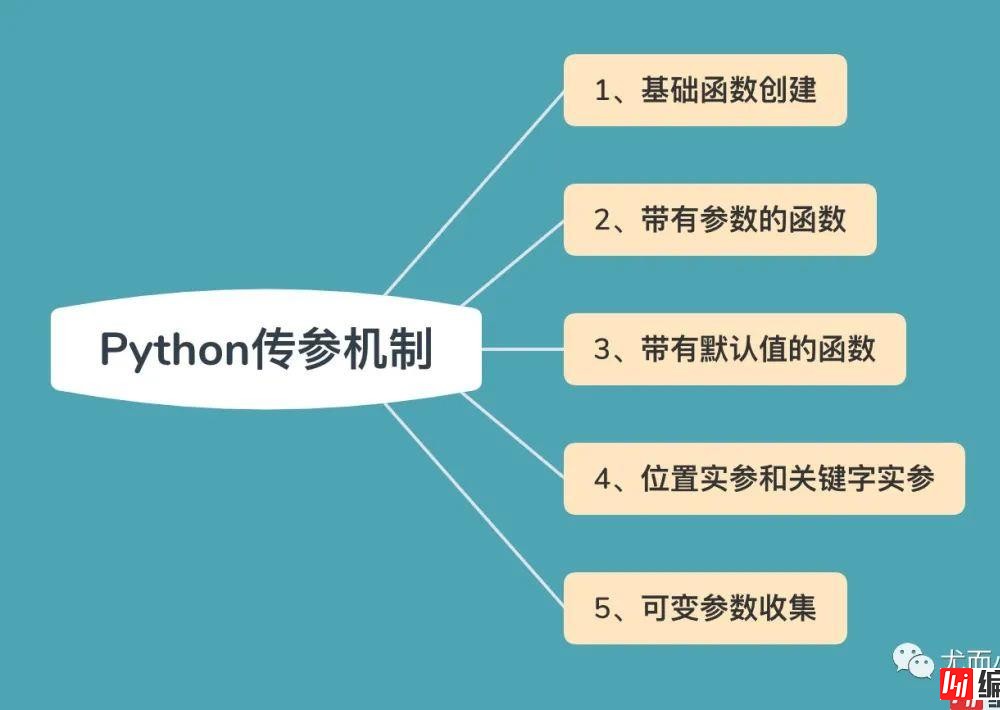Python 官方文档:入门教程 => 点击学习
目录一、最简单的函数(无返回值、参数)二、最简单的函数(带返回值、无参数)三、带一个参数(无默认值)四、带有多个参数(无默认值)五、参数设置默认值(一个参数)六、参数设置默认值(多个
大家好,我是Peter~
最近写了python函数的功能,犯了一些错误。本文主要是梳理下Python函数的传参机制,主要内容包含:

def hello_python():
print("hello python!")
hello_python() # 直接调用
输出:
hello python!
def hello_python():
data = "hello python!"
return data # data就是返回值
hello_python()
输出:
'hello python!'
def hello(data):
result = "hello " + data
return result
hello("python")
输出:
'hello python'
传入另一个值:
hello("java")
输出:
'hello java'
还可以在内部修改参数的信息:
def hello_name(name):
result = "Hello " + name.title() + "!"
return result
hello_name("tom")
'Hello Tom!'
hello_name("jack")
'Hello Jack!'
information("tom", 23)
'我叫Tom, 今年23岁'
information("JACK", 18)
'我叫Jack, 今年18岁'
def hello_name(name="Peter"):
result = "Hello " + name
return result
如果不给参数具体的值,就使用默认值
hello_name()
'Hello Peter'
给参数一个实际的值,比如下面的例子中Tom就是实际的值;这就是常说的实参
hello_name(name="Tom")
'Hello Tom'
def information(name="Peter", age=20):
data = "我是" + name + ", 今年" + str(age) + "岁"
return data
1、全部使用默认值:
information()
'我是Peter, 今年20岁'
2、全部传入实际的值:
information(name="Tom", age=27)
'我是Tom, 今年27岁'
3、只传入部分参数的实际值;未传入的使用默认值:
information(name="Tom")
'我是Tom, 今年20岁'
information(age=18)
'我是Peter, 今年18岁'
默认值的参数一定要放在最后面;具有默认值的参数一定要放在最后面
def information(name, age=20):
data = "我是" + name + ", 今年" + str(age) + "岁"
return data
information("Peter") # age默认使用20
'我是Peter, 今年20岁'
information(name="Peter")
'我是Peter, 今年20岁'
information("Peter", age=18)
'我是Peter, 今年18岁'
下面的方式直接报错:
information(age=18, "Peter")
File "<ipython-input-26-2d03cd04a05a>", line 1
information(age=18, "Peter")
^
SyntaxError: positional argument follows keyWord argument
information(age=18, name="Peter") # age默认使用20
'我是Peter, 今年18岁'
重点:在函数必须先列出没有默认值的形参,再列出有默认值的形参:
def information(age=20, name):
data = "我是" + name + ", 今年" + str(age) + "岁"
return data
File "<ipython-input-28-d36363c3194c>", line 1
def information(age=20, name):
^
SyntaxError: non-default argument follows default argument
如何理解有默认值的参数一定要放在最后面?
下面自定义个get_name的函数,传入第一个、最后一个和中间的名字,但是并不是每个人都有中间名字:
def get_name(first_name, last_name, middle_name=''):
if middle_name: # 如果存在中间名字
name = first_name + middle_name + last_name
else:
name = first_name + last_name
return name
get_name(first_name="张", last_name="飞", middle_name='')
'张飞'
get_name(first_name="孙", last_name="空", middle_name='悟')
'孙悟空'
如果不传递middle_name的结果肯定不是我们想要的:
get_name(first_name="孙", last_name="空")
'孙空'
def get_information(name, age):
data = "我是" + name + ", 今年" + str(age) + "岁"
return data
get_information("Tom", 20)
'我是Tom, 今年20岁'
get_information("20","Tom") # 一定要按照原来形参的顺序传递
'我是20, 今年Tom岁'
上面的结果肯定不是我们想要的
当使用关键字传递实参的时候,和顺序无关:
get_information(name="Tom", age=20)
'我是Tom, 今年20岁'
get_information(age=20, name="Tom")
'我是Tom, 今年20岁'
get_information("Tom", age=20)
'我是Tom, 今年20岁'
在使用的时候还是要按照原函数中的顺序,否则报错:
get_information(age=20,"Tom")
File "<ipython-input-39-bc20bc544493>", line 1
get_information(age=20,"Tom")
^
SyntaxError: positional argument follows keyword argument
有时候我们实现并不知道函数需要接受多少个参数,这个时候可以通过*args或者**kwargs的用法来收集任意数量的参数。
先介绍*args的使用。假设我们想把一个班级中每个同学的身高都变成以米为单位,即除以100:
def height(*args):
data = args
return data
height()
默认情况下函数收集到的是一个空元组:
()
height(178)
当传入数据的时候,以元组的形式表示:
(178,)
height(178,189)
(178, 189)
def height(*args):
for data in args: # 对args中的元素进行循环操作
print("身高是: {}m".format(data / 100))
height(189,180,167,172) # 调用
身高是: 1.89m
身高是: 1.8m
身高是: 1.67m
身高是: 1.72m
**kwargs允许将不定长度的键值对,作为参数传递给一个函数
def information(**kwargs):
data = kwargs
print(data)
默认情况下收集的是字典:
information(name="Peter")
{'name': 'Peter'}
information(name="Peter", age=23)
{'name': 'Peter', 'age': 23}
def information(**kwargs):
for k, v in kwargs.items():
print("{0} == {1}".format(k,v))
information(name="Peter")
name == Peter
information(name="Peter", age=23)
name == Peter
age == 23
information(name="Peter", age=23, height=175)
name == Peter
age == 23
height == 175
def fun(x, *args):
print("x:", x)
print("args:", args)
fun(1)
x: 1
args: ()
fun(1,2)
x: 1
args: (2,)
fun(1,2,3,4)
x: 1
args: (2, 3, 4)
fun(1,2,3,4,"Peter")
x: 1
args: (2, 3, 4, 'Peter')
def fun(x, **kwargs):
print("x:", x)
print("kwargs:", kwargs)
fun(1)
x: 1
kwargs: {}
fun(1,name="Peter")
x: 1
kwargs: {'name': 'Peter'}
fun(1,name="Peter",age=23)
x: 1
kwargs: {'name': 'Peter', 'age': 23}
def fun(x, *args, **kwargs):
print("x:", x)
print("args:", args)
print("kwargs:", kwargs)
fun(1)
x: 1
args: ()
kwargs: {}
fun(1,2,3)
x: 1
args: (2, 3)
kwargs: {}
fun(1,name="Peter",age=23)
x: 1
args: ()
kwargs: {'name': 'Peter', 'age': 23}
fun(1,2,3,name="Peter",age=23)
x: 1
args: (2, 3)
kwargs: {'name': 'Peter', 'age': 23}
kwargs = {"name":"Peter","age":23}
fun(1,2,3,**kwargs)
x: 1
args: (2, 3)
kwargs: {'name': 'Peter', 'age': 23}
以上就是一文搞懂Python的函数传参机制的详细内容,更多关于Python函数传参机制的资料请关注编程网其它相关文章!
--结束END--
本文标题: 一文搞懂Python的函数传参机制
本文链接: https://lsjlt.com/news/119241.html(转载时请注明来源链接)
有问题或投稿请发送至: 邮箱/279061341@qq.com QQ/279061341
2024-03-01
2024-03-01
2024-03-01
2024-02-29
2024-02-29
2024-02-29
2024-02-29
2024-02-29
2024-02-29
2024-02-29
回答
回答
回答
回答
回答
回答
回答
回答
回答
回答
0